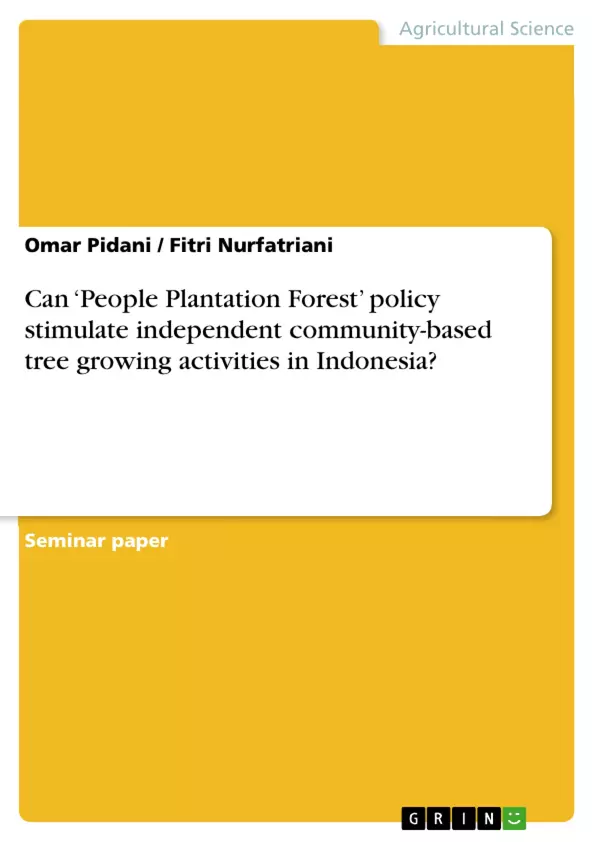Forest plantations are important in Indonesia for both conservation and development aspects of forest management. They can provide a sustainable supply of wood resources to meet the increasing demands of wood processing industries, rather than escalating pressure on natural forests reserved for conservation. Income from plantation forests can address the economic marginalisation of forest dependent people. Over the last three decades, three strategies have been put into practice to stimulate the development of both large-scale and small-scale plantation forestry in Indonesia: farm forestry, community forestry and community-company partnership. The success, however, has been limited. This paper reviews experience of these strategies in Indonesia, and considers this in the context of criteria and indicators for sustainable plantation development suggested in the literature. It then develops an analytical framework to assess whether a new policy proposed in Indonesia, “the People Plantation Forest” (PPF) policy, is likely to stimulate community-based tree growing activities.
Our analysis suggests that out of six elements identified in the framework, local institutional and capacity building, along with production technology and market access improvement are aspects that PPF might cope well and thus likely to encourage independent community-based tree growing activities. Whereas other elements such land and crop tenure security together with complex licensing and marketing bureaucracy are not dealt with thoroughly and consequently might still be major stumbling blocks in that regard.
For PPF to stimulate independent community-based tree growing, it requires commitment of government agencies across different jurisdictions to coordinate on the provision of technical, financial and regulatory support to minimise constraints in tree growing. Tenure security issue can be minimised through a more participatory approach for land demarcation and mapping; any initiatives conducted by members of community for such purpose should be accommodated. While complex licensing and marketing bureaucracy might be eased off through the creation of a simpler and more integrated procedure. This commitment of support, though, needs to be maintained in the long run given the nature of tree-growing ventures.
Inhaltsverzeichnis (Table of Contents)
- I. Introduction
- II. Methodology
- 2.1. The Research Methodology: the Thematic Analysis
- 2.2. Data Collection Method and Analysis
- III. The existing community-based tree growing strategies
- 3.1. Farm Forestry (Hutan Rakyat/HR)
- 3.2. Community Forestry Program (Program Hutan Kemasyarakatan)
- 3.3. Community-Company Partnership Program (Program Kemitraan)
- IV. Benefits and Constraints of the past strategies
- 4.1. Farm Forestry Program
- 4.1.1. Benefits
- 4.1.2. Constraints
- 4.2. community Forestry (CF) Program
- 4.2.1. Benefits
- 4.2.2. Constraints
- 4.3. Community-Company Partnership Program
- 4.3.1. Benefits
- 4.3.2. Constraints
- 4.1. Farm Forestry Program
- V. People Plantation Forest Policy
- VI. Discussion
- 6.1. Land and Crop Tenure Security
- 6.2. Viable Production Technology
- 6.3. Market Structure and Access
- 6.4. Crops Protection Capability
- 6.5. Local Institutional and Capacity Building
- 6.6. Complex Licensing and Marketing Bureaucracy
- VII. Conclusion
Zielsetzung und Themenschwerpunkte (Objectives and Key Themes)
This paper examines the potential of the 'People Plantation Forest' (PPF) policy in Indonesia to stimulate independent community-based tree growing activities. It aims to assess whether this new policy can overcome the challenges faced by previous community-based forestry initiatives in Indonesia. The paper analyzes the policy's effectiveness in addressing key constraints such as land tenure, production technology, market access, and institutional capacity.
- The effectiveness of the PPF policy in promoting independent community-based tree growing
- Analysis of the benefits and constraints of past forestry programs in Indonesia
- The role of land tenure security, production technology, and market access in facilitating tree growing activities
- The importance of local institutional capacity building and the role of government agencies in supporting community-based forestry
- The impact of licensing and marketing bureaucracy on the success of community-based tree growing initiatives
Zusammenfassung der Kapitel (Chapter Summaries)
The paper begins by introducing the context of community-based tree growing in Indonesia and outlining the challenges faced by farmers in this sector. It then delves into the methodology used for the research, which involves thematic analysis and document review. Chapter III explores the existing community-based forestry strategies in Indonesia, including farm forestry, community forestry, and company-community partnerships. The paper analyzes the benefits and constraints of each strategy, highlighting the factors that have contributed to their varied success. Chapter IV examines the 'People Plantation Forest' policy, outlining its objectives and key features. The paper then discusses the potential of this policy to address the challenges faced by previous initiatives, focusing on the areas of land tenure, production technology, market access, crop protection, institutional capacity, and licensing and marketing bureaucracy. Finally, the paper concludes with a discussion of the policy's potential and provides recommendations for its successful implementation.
Schlüsselwörter (Keywords)
The paper focuses on the key concepts of smallholder tree growing, People Plantation Forest (Hutan Tanaman Rakyat), community-based forestry, sustainable plantation development, land tenure security, production technology, market access, institutional capacity building, licensing and marketing bureaucracy, and rural poverty alleviation. The paper explores the effectiveness of the PPF policy in addressing these key challenges and fostering sustainable tree growing activities in Indonesia.
- Arbeit zitieren
- Omar Pidani (Autor:in), Fitri Nurfatriani (Autor:in), 2009, Can ‘People Plantation Forest’ policy stimulate independent community-based tree growing activities in Indonesia?, München, GRIN Verlag, https://www.hausarbeiten.de/document/337000


